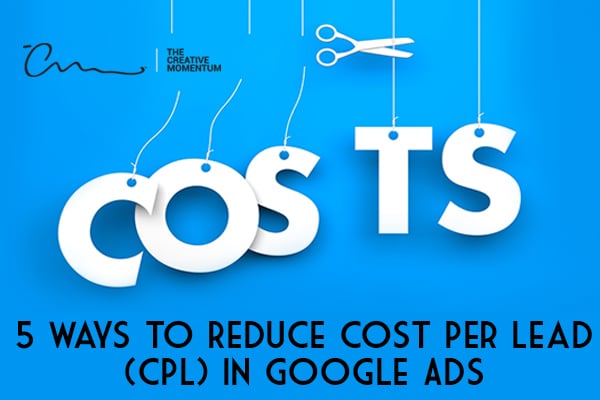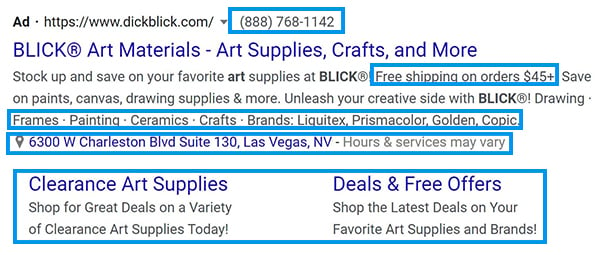
The success of a pay-per-click campaign is dependent on understanding your audience inside and out.
You can reduce the cost of your advertising if you know your audience: what are their habits? Can you predict their search queries? Do they have similar behaviors, like shopping online at a certain time of day? Is their geographical location important for converting?
Knowing these details and implications, and applying that knowledge to your Google Ads campaigns will help you reduce your advertising costs overall, and reduce your cost per lead.
Here are five ways to reduce your Google Ads cost per lead (CPL).
1. Review and Update Your Keywords
 Sometimes going back to basics can help you manage your Google Ads and, as a result, reduce your CPL. Run an ad performance report and analyze each keyword. Are there some keywords that are too general? Out of date? Others that are bringing in lots of people who don’t convert?
Sometimes going back to basics can help you manage your Google Ads and, as a result, reduce your CPL. Run an ad performance report and analyze each keyword. Are there some keywords that are too general? Out of date? Others that are bringing in lots of people who don’t convert?
When it comes to PPC, the more specific you can be, the better. While it’s easy to fall back on general keywords, the more you can pinpoint a specific audience, the more likely you are to create relevant ads, keywords, and content and to convert potential customers into buyers.
For example, while a broad keyword might include “a car driver in California,” a phrase match might be “a Toyota driver who lives in Southern California.” An exact match might be “a Toyota Prius driver in Los Angeles.” When you can narrow down to specific Los Angeles Prius drivers, you can write keywords that will speak to their specific needs and increase your click-through rates (CTR).
It’s always a good idea to do a biannual audit of your keywords to make sure that what worked for your website in the past is still working. Often, user behavior changes, or maybe keywords that used to convert don’t anymore. Regardless of the reason, you’ll want your keywords to be as up to date and relevant as possible to avoid paying for needless clicks.
2. Use Negative Keywords
While conducting a review of your search queries, you're almost certain to find searches that aren't great fits for your products or services, and shouldn't therefore trigger your ads. By watching for this behavior in your search queries, you can find potential negative keywords to help reduce your CPL.
Negative keywords are the keywords you want to eliminate from your search queries, ones that originate from sources who are not likely to convert. For example, if your company is selling family law consultations, you might want to designate the term “free” as a negative keyword to eliminate searches looking for free legal advice.
Two ways that you can search for negative keywords are in the Google Keyword Planner or the Search Query Report. While both are generally used to help generate new keywords, you can also home in on the search queries that aren’t suitable and add them to your negative keyword list for your ad campaigns. Correctly identifying and using negative keywords lowers your CPL in the long run.

3. Improve Your Quality Score
Search engines reward advertisers who create intelligent and relevant ad campaigns by charging them fewer dollars per click. This means that ads that are more specific and relevant to your audience will cost you less than ads with lower quality scores. In fact, you can save up to 50% on your PPC with a high quality score.
Your quality score is based on three metrics:
- CTR
- Ad relevance
- Landing page experience
So time and money spent on increasing your CTR, doing A/B testing on landing pages, and checking load times on your site—are methods that can affect your quality score, which can also lower your CPL. Read our blog on the Best Ways to Improve Google Quality Score for more detailed information on how to increase your quality score.
4. Audit Your Ad Performance
Segment and evaluate your campaigns by device, geographical location, and network or by the hour of the day and the day of the week. Do you see any patterns? Do more conversions take place on the weekends? Do conversions not happen on mobile devices or tablets? Or maybe you notice users in geographical locations that are clicking on your ads a lot but aren’t buying anything on your website.
Drill down into your campaigns and exclude these audience segments from your ads. This sort of detail will reduce your CPL and help you understand your audience’s behavior better.
5. Use Ad Extensions
Google Ads extensions generally improve CTR by extending your ad and offering more information on the search engine results page. Extensions can be call buttons, links to your website, location information, phone numbers, and more. Keep in mind that extensions are not guaranteed to show on every search query, but the better your quality score, the more likely they are to appear to potential customers. And there’s no additional cost to use them, which is an added benefit.
Here are some different types of extensions you can use in your Google Ads:
Types of Manual Extensions
- Call extensions - These are good for businesses that offer urgent services or want to provide a phone number for users to text or call before they reach your website.
- Callout extensions - Callout extensions are good for any type of business. They allow you to highlight additional information or web pages that may make a conversion more likely.
- Lead form extensions - These fillable forms allow you to obtain your customers’ contact information easily and generate valuable leads.
- Location extensions - These are good for businesses that are hard to find or need to get customers into the store to convert.
- Structured snippet extensions - Like sitelink and callout extensions, structured snippet extensions allow you to customize your search results and provide more detail that converts new customers. The additional information you provide can increase CTR and your ad’s relevance.
- Sitelink extensions - These extensions provide more options to users and allow them to go to multiple web pages from your ad.
- App extensions - These extensions allow users to download your mobile or tablet app in your ads.
- Price extensions - Price extensions show up to eight cards that provide different details of products or services you offer. Customers are given a wide range of products or services to choose from, and this leads to more chances of conversion.
Types of Automatic Extensions for Google Ads
- Seller ratings - Seller ratings are good for businesses or products with five-star ratings.
- Dynamic sitelink extensions - These are especially helpful in remarketing campaigns, when you’re trying to get your customer to complete a sale.
Now that you know that understanding your audience is the best way to optimize your Google Ads, you can get started on lowering your cost per lead. But if you need help with managing your Google Ad campaigns, get in touch. We'd love to bring our strength in PPC strategy and optimization to your business.



